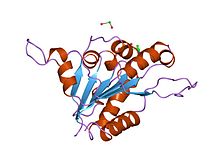
Back Flavoprotein BS Flavoproteïna Catalan Flavoprotein Czech Flavoproteine German Flavoproteína Spanish Flavoprotéine French Flavoproteína Galician Flavoprotein ID Flavoproteine Italian フラボタンパク質 Japanese
| Flavoprotein | |||||||||
|---|---|---|---|---|---|---|---|---|---|
 the fmn binding protein athal3 | |||||||||
| Identifiers | |||||||||
| Symbol | Flavoprotein | ||||||||
| Pfam | PF02441 | ||||||||
| InterPro | IPR003382 | ||||||||
| SCOP2 | 1e20 / SCOPe / SUPFAM | ||||||||
| |||||||||
Flavoproteins are proteins that contain a nucleic acid derivative of riboflavin. These proteins are involved in a wide array of biological processes, including removal of radicals contributing to oxidative stress, photosynthesis, and DNA repair. The flavoproteins are some of the most-studied families of enzymes.
Flavoproteins have either FMN (flavin mononucleotide) or FAD (flavin adenine dinucleotide) as a prosthetic group or as a cofactor. The flavin is generally tightly bound (as in adrenodoxin reductase, wherein the FAD is buried deeply).[1] About 5-10% of flavoproteins have a covalently linked FAD.[2] Based on the available structural data, FAD-binding sites can be divided into more than 200 different types.[3]
90 flavoproteins are encoded in the human genome; about 84% require FAD and around 16% require FMN, whereas 5 proteins require both.[4] Flavoproteins are mainly located in the mitochondria.[4] Of all flavoproteins, 90% perform redox reactions and the other 10% are transferases, lyases, isomerases, ligases.[5]
- ^ Hanukoglu I (2017). "Conservation of the Enzyme-Coenzyme Interfaces in FAD and NADP Binding Adrenodoxin Reductase-A Ubiquitous Enzyme". Journal of Molecular Evolution. 85 (5): 205–218. Bibcode:2017JMolE..85..205H. doi:10.1007/s00239-017-9821-9. PMID 29177972. S2CID 7120148.
- ^ Abbas, Charles A.; Sibirny, Andriy A. (2011-06-01). "Genetic Control of Biosynthesis and Transport of Riboflavin and Flavin Nucleotides and Construction of Robust Biotechnological Producers". Microbiology and Molecular Biology Reviews. 75 (2): 321–360. doi:10.1128/MMBR.00030-10. ISSN 1092-2172. PMC 3122625. PMID 21646432.
- ^ Garma, Leonardo D.; Medina, Milagros; Juffer, André H. (2016-11-01). "Structure-based classification of FAD binding sites: A comparative study of structural alignment tools". Proteins: Structure, Function, and Bioinformatics. 84 (11): 1728–1747. doi:10.1002/prot.25158. ISSN 1097-0134. PMID 27580869. S2CID 26066208.
- ^ a b Lienhart, Wolf-Dieter; Gudipati, Venugopal; Macheroux, Peter (2013-07-15). "The human flavoproteome". Archives of Biochemistry and Biophysics. 535 (2): 150–162. doi:10.1016/j.abb.2013.02.015. PMC 3684772. PMID 23500531.
- ^ Macheroux, Peter; Kappes, Barbara; Ealick, Steven E. (2011-08-01). "Flavogenomics – a genomic and structural view of flavin-dependent proteins". FEBS Journal. 278 (15): 2625–2634. doi:10.1111/j.1742-4658.2011.08202.x. ISSN 1742-4658. PMID 21635694. S2CID 22220250.
© MMXXIII Rich X Search. We shall prevail. All rights reserved. Rich X Search